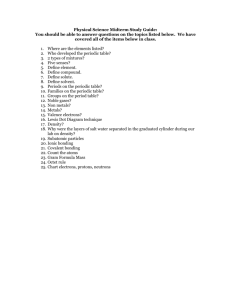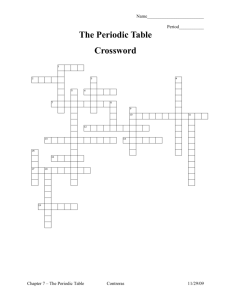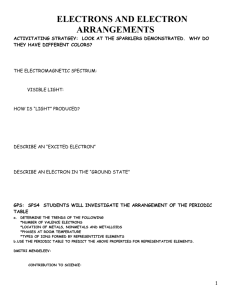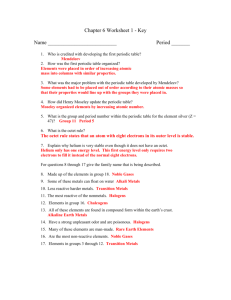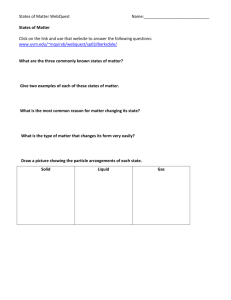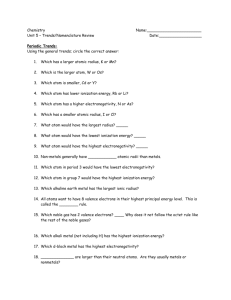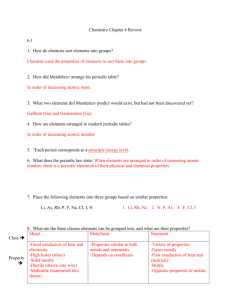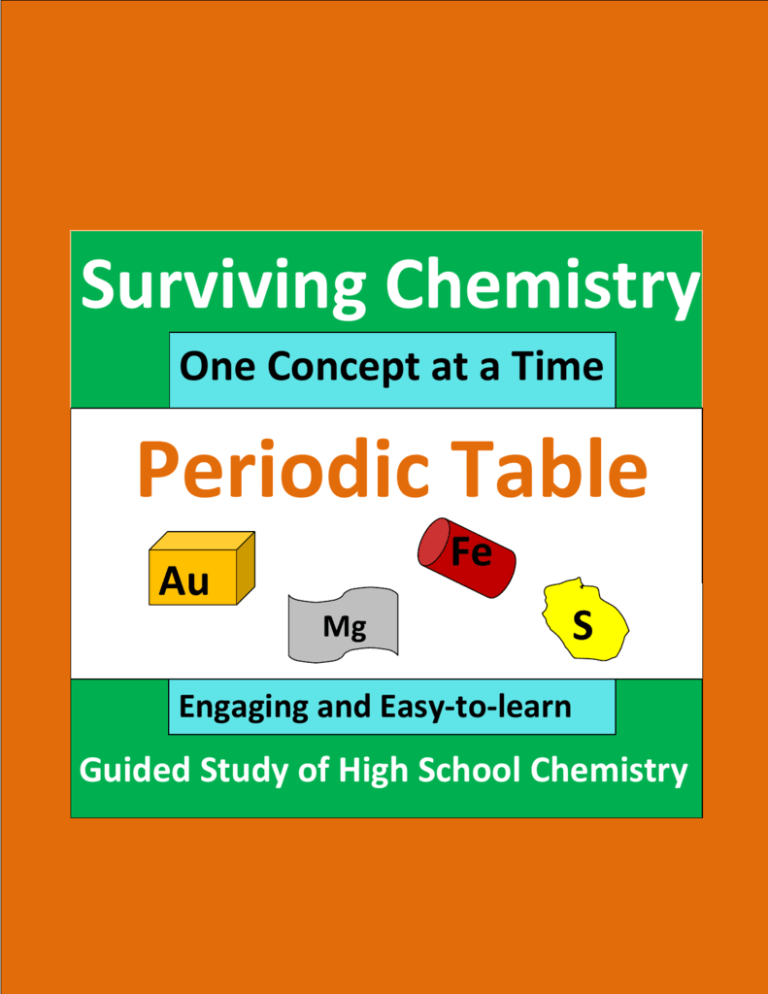
Surviving Chemistry
One Concept at a Time
Periodic Table
Fe
Au
Mg
S
Engaging and Easy-to-learn
Guided Study of High School Chemistry
.
Guided Study Book
One Concept at a Time
A Guided Study and Workbook for High School Chemistry
2012 Revision
Effiong Eyo
E3 Scholastic Publishing
Surviving Chemistry Book Series
Student and Teacher Friendly HS Chemistry books that will:
excite students to study
engage students in learning
enhance students’ understanding
For more information and to order:
e3chemistry.com
(877) 224 – 0484
info@e3chemistry.com
.
Topic 2 – The Periodic
Table
Topic outline
In this topic, you will learn the following concepts:
. Arrangements of the elements
. Groups of elements
. Periodic
and their
trends
properties
. Types of elements and their properties
. Periodic trends. Allotropes
. Groups of elements and their properties
. Allotropes
Lesson 1 – Arrangement of the Elements
Introduction:
The modern Periodic Table contains all known elements that are arranged in the order of increasing
atomic number.
There are more than on hundred known elements. Most of the elements are natural occurring, while
others have been artificially produced in laboratories. Important information about an element can be
found in the box of each element on the Periodic Table .
In this lesson, you will learn important facts about the Periodic Table, and the different arrangements of
the elements.
1. Properties of the Modern Periodic Table
Concept Facts: Study to remember the followings about the Periodic Table.
. Elements are arranged in order of increasing atomic numbers
. Chemical properties of the elements are periodic function of their atomic numbers
. The elements on the Periodic Table are categorized as metals, nonmetals, or metalloids
. More than two thirds of the elements are metals
. The Periodic Table contains elements that are in all three phases (solid, liquid, and gas) at STP
. The majority of the elements exist as solids at STP
. Only two (mercury and bromine) are liquids at STP
. A few elements are gases at STP
The following information can be found in the box of each element.
LOOK on the Periodic Table for these two elements: Oxygen and Gold
NOTE all the information you can get from the box of each element.
196.967
Atomic Mass
15.999
-2
O
8
2–6
+1
+2
Selected oxidation states (charges)
Au
Element’s symbol
79
Atomic number
Electron configuration
2 – 8 – 18 -32 -18 - 1
Information listed in the box of each element reveal a lot about the atomic structure of the element.
..
LOOKING Ahead
Topic 3 - The Atomic Structure. You will learn to relate information on
the Periodic Table to the atomic structures.
Copyright © 2012 E3 Scholastic Publishing. All Rights Reserved.
e3chemistry.com
29
Topic 2 - The
. Periodic Table
2. Groups and Periods
The elements are placed in Groups and Periods. Every element has a Group number and a Period number.
For example: Element phosphorous (P) is in Group 15, Period 3.
Groups (families) are the vertical arrangements of the elements.
. Elements in the same group have the same number of valance electrons and similar chemical properties
. There are eighteen (18) groups on the Periodic Table of the Elements
The Group names are listed below.
Group 1 :
Alkali metals
Group 2 :
Alkaline earth metals
Group 3 – 12:
Transition metals
Group 17:
Halogens
Group 18:
Noble (Inert) gases
Periods (rows) are the horizontal arrangements of the elements.
. Elements in the same Period have the same number of occupied electron shells (energy levels)
. There are seven (7) periods on the Periodic Table of the Elements
Periodic Law: The properties of the elements are periodic function of their atomic numbers.
In other words, by arranging the elements in the order of increasing atomic numbers, elements with similar
properties end up in the same group.
3. Arrangements of the Elements: Practice Problems
Practice 1
Which of the following information cannot be found in the
box of an element on the Periodic Table?
1) Oxidation state
3) Atomic number
2) Phase
4) Atomic mass
Practice 2
The Periodic Table of the Elements contains elements that
are
1) Solids only
3) Liquids and gases only
2) Solid and liquids only
4) Solid, liquids and gases
Practice 3
The observed regularities in the properties of the elements
are periodic functions of their
1) Atomic numbers
3) Atomic mass
2) Oxidation state
4) Reactivity
Practice 4
The similarities in chemical properties of elements within
the same group is due to similarity in
1) Number of electron shells 3) Oxidation state
2) Valance electrons
4) Chemical properties
Practice 5
Majority of the elements on the Periodic Table are
1) Metals
3) Metalloids
2) Nonmetals
4) Noble gases
30
Practice 6
Which of these elements has similar chemical
properties as iodine?
1) Xe
2) Te
3) Br
4) Se
Practice 7
Which list contains elements with greatest
variation in chemical properties?
1) O, S and Se
3) N, P and As
2) Be, N, O
4) Ba, Sr and Ca
Practice 8
Which two elements have the same number of
occupied electron shells?
1) Mg and Be
3) Mg and O
2) Mg and Al
4) Mg and Ca
Practice 9
Element Oxygen and Sulfur can both form a bond
with sodium with similar chemical formula. The
similarity in their formula is due to
1) Oxygen and Sulfur having the same
number of kernel electrons
2) Oxygen and sulfur having the same
number of valance electrons
3) Oxygen and sulfur having the same
number of protons
4) Oxygen and sulfur having the same
molecular structure
Copyright © 2012 E3 Scholastic Publishing. All Rights Reserved.
e3chemistry.com
Topic 2 - The
. Periodic Table
Lesson 2 – Types of elements and their Properties
Introduction
There are three general categories of elements: metal, nonmetals, and metalloids.
Elements in one category have a set of physical and chemical properties that are used to distinguish
them from elements in the other categories.
In this lesson, you will learn about the three types of elements, their locations on the Periodic Table, and
their properties.
4. Types of elements
Location of metals, metalloids, and nonmetals
1
H
2
Li
Be
Na
Mg
3
4
5
6
7
K
Ca
Sc
Ti
V
Cr
Rb
Sr
Y
Zr
Nb
Cs
Ba
Lu
Hf
Fr
Ra
Lr
Rf
metals
18
nonmetals
metalloids
12
15
16
17
He
B
C
N
O
F
Ne
Al
Si
P
S
Cl
Ar
As
Se
Br
Kr
Sb
Bi
Te
Po
I
Xe
At
Rn
9
Mn
Fe
Co
Ni
Cu
Zn Ga
Mo
Tc
Ru
Rh
Pd
Ag
Cd
In
Ge
Sn
Ta
W
Re
Os
Ir
Pt
Au
Hg
Ti
Pb
Db
Sg
Bh
Hs
Mt
Ds
Rg
Cn
La
Ce
Pr
Nd
Pm Sm
Eu
Gd
Ac
Th
Pa
U
Pu
11
14
8
Np
10
13
Am Cm
Uut Uuq Uup Uuh
Uus Uuo
Tb
Dy Ho
Er
Tm Y b
Bk
Cf
Fm
Md No
Es
5. Physical properties of elements
There are several physical properties that can be used to describe and identify the elements.
The following is a list of these physical properties and their definitions.
Concept Facts: Study and to remember these properties.
Malleable describes a solid that is easily hammered into a thin sheet.
Ductile describes a solid that is easily drawn into thin wire.
Brittle describes a solid that is easily broken or shattered into pieces when struck
Luster describes the shininess of a substance.
Conductivity describes the ability to conduct heat or electricity.
Electronegativity describes atom’s ability to attract electrons from another atom during bonding.
Ionization energy describes an atom’s ability to lose its most loosely bound valance electrons.
Atomic radius describes the size of the atom of an element.
Density describes the mass to volume ratio of an element.
Use Reference Table S to find and compare electronegativity, ionization energy, atomic radius, and
density values of the elements.
Copyright © 2012 E3 Scholastic Publishing. All Rights Reserved.
e3chemistry.com
31
Topic 2 -The
. Periodic Table
6. Metals
Metal elements are located to the left of the Periodic Table.
All elements in Group 1 – 12 (except hydrogen) are classified as metals.
The rest of the metal elements are located near the top of Groups 13 through 17
The majority ( about 75%) of the elements are metals.
Below are some general properties (characteristics) of metals.
Iron (Fe)
Concept Facts: Study to remember these properties.
. Almost all metals are solids. Exception is mercury (Hg) , which is a liquid metal
. Solid metals are malleable, ductile, and have luster
. Metals tend to have high heat (thermal) and electrical conductivity due to their mobile valance electrons
. Metals tend to have low electronegativity values (because they do not attract electrons easily)
. Metals tend to have low ionization energy values (which is why metals lose their electrons easily)
. Metals generally lose electrons and form positive ions
. Radius (size) of a metal atom decreases as it loses electrons and form a positive ion
. The size of a positive (+) metal ion is always smaller than the size of the neutral metal atom
7. Metalloids
Metalloids (semi-metals) are the seven elements located between the metals and the nonmetals.
Metalloid elements are located on the Periodic Table along the thick zigzag line.
Below are some generally properties (characteristics) of metalloids.
Concept Facts: Study to remember these properties.
. Metalloids tend to have properties of both metals and nonmetals
. Metalloids properties are more like those of metals, and less like those of nonmetals
. Metalloids exist only as solids at STP.
Tellurium (Te)
8. Nonmetals
Nonmetal elements are located to the right of the Periodic Table.
All elements in Groups 17 and 18 are classified as nonmetals. The rest of the nonmetals are located near
the bottom of Group 14, 15, and 16. Hydrogen (in Group 1) is also a nonmetal.
Below are some general properties (characteristics) of nonmetals.
Concept Facts: Study to remember these properties.
. Nonmetals are found in all three phases: solid, liquid, and gas.
Sulfur (S)
. Most nonmetals exist as molecular gases and solids. Bromine is the only liquid nonmetal
. Solid nonmetals are generally brittle and dull (lack luster, not shiny)
. Nonmetals have low (poor) electrical and heat conductivity
. Nonmetals tend to have high electronegativity values ( because they attract and gain electrons easily)
. Nonmetals tend to have high ionization values (which is why nonmetals don’t lose electrons easily)
. Nonmetals generally gain electrons and form negative ions
. Radius of a nonmetal atom generally increases as it gains electrons and forms a negative ion
. The size of a negative ( - ) nonmetal ion is always bigger than its neutral nonmetal atom
32
Copyright © 2012 E3 Scholastic Publishing. All Rights Reserved.
e3chemistry.com
Topic 2 - The. Periodic Table
9. Types of elements: Summary of properties of metals, nonmetals, and metalloids
Phases Physical
at STP properties
Metals
Solid Malleable
Liquid Luster
Ductile
Nonmetals Solid Brittle
Liquid Dull
Gas
Metalloids Solid Properties of
metals and
only
Conductivity Electronegativity
Ionization Electrons Common ion Ionic size
energy
(radius)
In bonding
High
Low
Low
Lose
+ (positive) Smaller
electrons
than
atom
Low
High
High
Gain
electrons
Low
varies
varies
nonmetals
- (negative) Bigger
than
atom
Lose
+ (positive) Smaller
electrons
than
atom
10. Types of element: Practice problems
Practice 10
Elements that can be hammered into thin sheets are said
to be
1) Ductile
2) Luster
3) Malleable 4) Brittle
Practice 11
The tendency for an atom to give away its electrons during
bonding is measured by its
1) Atomic radius value
3) Electronegativity value
2) Density value
4) Ionization energy value
Practice 12
Nonmetal elements on the Periodic Table can be found in
which phase or phases at STP?
1) Solid only
3) Solid or liquid only
2) Liquid only
4) Solid, liquid and gas
Practice 13
Which two characteristics are associated with nonmetals?
1) Low first ionization energy and low electronegativity
2) Low first ionization energy and high electronegativity
3) High first ionization energy and low electronegativity
4) High first ionization energy and high electronegativity
Practice 14
Metalloids tend to have properties resembling
1) Nonmetals only
2) Metals only
3) Both metals and nonmetals
4) Neither a metal nor a nonmetal
Practice 15
Which is a property of most metals?
1) They tend to gain electrons easily when bonding.
2) They tend to lose electrons easily when bonding.
3) They are poor conductors of heat.
4) They are poor conductors of electricity.
Copyright © 2012 E3 Scholastic Publishing. All Rights Reserved.
Practice 16
Which of these elements is a metalloid?
1) Gallium
2) Germanium
3) Phosphorous
4) Tin
Practice 17
Which list consists of a metal, nonmetal,
and metalloid respectively?
1) Al, B, Si
3) Ni, Si, P
2) Cr, C, Cl
4) C, Si, Ge
Practice 18
Which element is brittle and a non
conducting solid?
1) S
2) Ne
3) Ni
4) Hg
Practice 19
Which of these elements has high thermal
and electrical conductivity?
1) Iodine
3) Carbon
2) Phosphorous
4) Iron
Practice 20
Which properties best describes the
element mercury?
1)
2)
3)
4)
It has luster
It is brittle
It has a high electronegativity value
It a poor electrical conductor
Practice 21
Which is true of element carbon?
1) It is malleable
2) It has Luster
3) It has low electrical conductivity
4) It is a gas at STP
e3chemistry.com
33
Topic 2 - The .Periodic Table
Lesson 3 – Groups name and their properties
Introduction
There are 18 Groups (vertical arrangements) on the Periodic Table. Elements within each group share
similar chemical characteristics because they have the same number of valance electrons.
In this lesson you will learn more about the groups, and general properties that characterized members
of each group.
11. The Periodic Table of the Elements
1
1.007
Period 1
+1
H
1
Alkali metals (1)
Metals
Alkaline earth metals (2)
Metalloid elements
Transition metals (3-12)
Nonmetals
1
2
6.941
Period 2
Period 4
Period 5
Period 6
+2
Be
4
2-1
2-2
22.989
Period 3
+1 9.012
Li
3
+1 24.305
Na
11
Mg
12
2-8-1
2-8-2
39.09
+1 40.08
Halogens (17)
Noble gases (18)
+2
Group
3
+2 44.9559
19
20
Sc
21
2-8-8-1
2-8-8-2
2-8-9-2
K
Ca
+3 47.88
2-8-10-2
+2 54.938
Cr
+4
24
Mn
+6 25
+3
2-8-11-2
Nb
41
2-8-18-8-1
2-8-18-8-2
2-8-18-9-2
2-8-18-10-2
2-8-18-12-1
138.906
+3 178.49
La
(223)
57
+1 226.025
+2
227.028
+4 180.948
Ac
87
-18-32-18-8-1
-18-32-18-8-2
-18-32-18-9-2
89
2-8-13-2
+3 95.94
+5
+6
2-8-18-13-1
+5 183.85
+2 58.933
+3
26
+7 2-8-14-2
+3 (98)
Mo
42
+6
+4 190.2
Re
+6
Os
2-8-18-16-1
+3 192.22
+3
Ir
+4
+4
73
74
75
-18-32-11-2
-18-32-12-2
-18-32-13-2
(262)
(262)
(272)
(277)
(276)
Db
105
Sg
106
Bh
107
Hs
108
Mt
109
104.12
+3
Ce
58
140.908
+3 144.24 +3
Pr
Nd
60
59
+7 76
-18-32-14-2
(145)
+3
Rh
45
-18-32-10-2
Rf
104
+3
+3 102.906
Ru
44
+7
2-8-18-14-1
2-8-18-15-1
+6 183.85
+2
Co
27
2-8-15-2
+3 101.07
Tc
43
W
Ta
+4
9
72
+3 (261)
Ra
88
Fr
+4 92.906
Hf
+3
+5 2-8-13-1
Zr
40
+2
+2 55.847
+3 Fe
+2 51.996
Y
39
Ba
56
8
V
+4 23
+3
Sr
38
+1 137.33
7
+2 50.9414
+1 87.62
Cs
55
+3 91.224
6
Rb
37
2-8-18-18-8-1 2-8-18-18-8-2 -18-18-9-2
Period 7
Ti
22
5
85.468
132.91
+2 88.905
4
+3
Pm
61
77
-18-32-15-2
150.36
+2
Sm
62
+3
Rare Earth metals
232.038
Th
90
34
+4
231.036
Pa
91
+4 238.029
+5
U
92
Copyright © 2012 E3 Scholastic Publishing. All Rights Reserved.
+3 237.029
+4
+5
+6
Np
93
+3 (244)
+4
+5
+6
Pu
94
e3chemistry.com
+3
+4
+5
+6
Topic 2 -The
. Periodic Table
Atomic mass
-3
+3
+5
30.973
P
Element’s symbol
Atomic number
Selected
oxidation
states
15
Electron configuration
2–8–5
18
4.002
0
Period 1
He
2
2
13
10.81
C
6
2-3
2-4
Si
14
2-8-3
2-8-4
Ni
28
+1 65.39
+2 69.72
+3 72.59
29
Zn
30
Ga
31
Ge
32
2-8-18-1
2-8-18-2
2-8-18-3
2-8-18-4
11
+2 63.546
+3 Cu
2-8-16-2
106.42
+2 107.868
Pd
46
+4
2-8-18-18
195.08
Pt
12
+2
-4 30.973
+2
+4
+3 118.71
Sn
50
2-8-18-18-1
2-8-18-18-2
2-8-18-18-3
2-8-18-18-4
+1 204.383
-3 32.06
-2 35.453
-1 39.948
+1
Ar
+3
+5 18
+7
+5
S
16
2-8-6
+3 207.2.
-+3
3 127.60
+3
Te
52
-2 79.904
-1 83.80
Br
+6 35
+1
+4
+5
2-8-18-7
I
53
+5
+6
2-8-18-18-5
2-8-18-18-3
2-8-18-18-6
2-8-18-18-7
+2 208.980
+3 (209)
Po
84
+2 (210)
(210)
At
85
Kr
-1 131.29
+1
Xe
+5
+7
54
+2 (222)
+2
80
81
82
-18-32-18-2
-18-32-18-3
-18-32-18-4
-18-32-18-5
+5
-18-32-18-7
-18-32-18-6
-18-32-18-8
(281)
(280)
(285)
(284)
(289)
(288)
(292)
(?)
(294)
Rg
111
Cn
112
Uut
113
Uuq
114
Uup
115
Uuh
116
Uus
117
Uuo
118
+3 162.50
+3 164.930
Ds
110
151.96
+2 157.25
Eu
63
+3
(243)
+3
+ 4 (247)
+5 Cm
+6
Am
95
Gd
64
96
+3 158.925
Tb
65
Dy
66
+3 (247)
+3 (251)
Bk
97
Cf
98
Ho
67
+3 167.26
+3 168.934
+4
+3 173.04
+4
+4
+2 174.967
Er
68
Tm
69
Yb
70
+3 (252)
(257)
(258)
(259)
(260)
Es
99
Fm
100
Md
101
No
102
Lr
103
Copyright © 2012 E3 Scholastic Publishing. All Rights Reserved.
0
+2
0
+2
+4
+6
+3
0
Rn
86
-18-32-18-1
+5
Period 3
Period 4
Period 5
2-8-18-18-8
79
+4
0
36
-18-32-17-1
+2
Period 2
2-8-18-8
- 2 126.905
+4
0
2-8-8
2-8-7
2-8-18-6
+2 121.75
114.82
Sb
In
49
51
Se
34
Cl
17
78
+3
Pb
2-8-18-3
2-8-18-5
+4
+4
+6
Bi
83
+4
Ti
2-8
+3
-3 78.96
In
49
Hg
2-7
+4
+2 114.82
+1 200.59
2-6
+3
+2
-1 20.179
Ne
10
Ga
As
+4
+4 33
31
Cd
48
-2 18.998
F
9
-4 74.921
69.72
+1 112.41
Au
P
15
15.999
17
O
8
2-8-5
Ag
47
+2 196.967
+2
+3
+4
+5
N
+4 7
2-5
+3 28.085
16
-3
-4 14.006
+2
Al
13
10
15
+3 12.011
B
5
26.981
58.69
14
Lu
71
e3chemistry.com
Period 6
Period 7
+3
Lanthanoid
Series
Actinoid
Series
35
Topic 2 -. The Periodic Table
12. Group 1: Alkali Metals
Alkali metals are elements in Group 1 of the Periodic Table.
H
Members include lithium, sodium, potassium, rubidium, cesium and francium.
1
Hydrogen is not an alkali metal even though it is often placed in Group 1.
Group 1
Alkali Group 2
Li
3
Properties (characteristics) of alkali metals are listed below.
Concept Facts: Study to remember these properties.
. One valance (outer shell) electron
. Form positive one ( +1) ion from losing one valance electron during bonding
Na
11
K
19
. Very low electronegativity and very low ionization energy values.
. Found in nature as compounds, not as free elements, due to high reactivity
. Are obtained from electrolytic reduction of fused salts ( NaCl, KBr..etc)
. If X represents a Group 1 atom
XY is the general formula of a Group 1 atom bonding with a Group 17 halogen (Y)
X2O is the general formula of a Group 1 atom bonding with O (to form an oxide)
. Francium (Fr) is the most reactive metal in Group 1, and of all metals
. Francium is also radioactive.
Rb
37
Cs
55
Fr
87
. All alkali metals exist as solids at STP
13. Group 2: Alkaline Earth metals
Alkaline Earth metals are elements in Group 2 of the Periodic Table.
Group 1
Members include beryllium, magnesium, calcium, strontium, barium, and radium.
Alkaline
Earth
Properties (characteristics) of alkaline earth metals are listed below.
Be
Concept Facts: Study to remember these properties.
4
Mg
. Two valence (outer shell) electrons
12
. Form positive two (+2) ion from losing all two valance electrons during bonding
Ca
. Found in nature as compounds, not as free elements, due to high reactivity
20
. Are obtained from fused salt compounds ( MgCl2, CaBr2..etc)
Sr
. If M represents a Group 2 atom
MY2 is the general formula of a Group 2 atom bonding with a Group 17 halogen (Y)
MO is the general formula of a Group 2 atom bonding with O (to form an oxide)
. Radium (Ra) is the most reactive metal in this group. Radium is also radioactive.
. All alkaline earth metals exist as solids at STP
Group 2
38
Ba
56
Ra
88
36
Copyright © 2012 E3 Scholastic Publishing. All Rights Reserved.
e3chemistry.com
Topic 2 -.The Periodic Table
14. Group 3 – 12: Transition metals
Transition metals are elements in Groups 3 – 12 of the Periodic Table
Properties of these elements vary widely. However, a few unique properties can be observed among them.
Properties (characteristics) of transition metals are listed below.
Concept Facts: Study to remember these properties.
. They tend to form multiple positive oxidation numbers
. They can lose electrons in two or more different sublevels of their atoms
. Their ions usually form colorful compounds
CuCl2 – is a bluish color compound
FeCl2 - is an orange color compound
Transition metals
3
4
5
6
7
8
9
10
11
12
Sc
Ti
V
Cr
Mn
Fe
Co
Ni
Cu
Zn
Y
Zr
Nb
Mo
Tc
Ru
Rh
Pd
Ag
Cd
La
Hf
Ta
W
Re
Os
Ir
Pt
Au
Hg
Ac
Rf
Db
Sg
Bh
Hs
Mt Uun Uuu Uub
15. Group 17: Halogens
Halogens are elements in Group 17 of the Periodic Table.
Group 18
Members include fluorine, chlorine, bromine, and iodine
Group 17
Halogens
Properties (characteristics) of halogens are listed below.
F
Concept Facts: Study to remember these properties.
9
. They exist as diatomic (two-atom) elements; (F2, Cl2, Br2)
Cl
. Seven (7) valance electrons
17
. Very high electronegativity and high ionization energy values
Br
. Form negative one (-1) ion from gaining one electron to fill their valance shell
. F and Cl are obtained from their fused salt ( NaF, NaCl..etc) because of high reactivity
I
. If Y is a Group 17 halogen
XY is the general formula of a Group 17 halogen bonding with a Group 1 (X) atom
MY2 is the general formula of a Group 17 atom bonding with a Group 2 (M) atom
. The only group containing elements in all three phases at STP
Gases (Fluorine and Chlorine) Liquid (Bromine)
35
53
At
85
Solid (Iodine)
. Fluorine is the most reactive of the group, and the most reactive nonmetal overall
. Astatine (At) in this group is a radioactive element, and behaves quiet differently from the other four
Copyright © 2012 E3 Scholastic Publishing. All Rights Reserved.
e3chemistry.com
37
Topic 2 - The .Periodic Table
16. Group 18 - Noble (inert) gases
Noble gases are elements in Group 18 of the Periodic Table.
Group 18
Members include helium, neon, argon, krypton, xenon, and radon
Noble gases
Properties (characteristics) of noble gases are listed below.
He
Group 17
Concept Facts: Study to remember these properties.
2
Ne
. They exist as monatomic (one - atom) nonpolar elements ( Ne, He, Kr…)
. All are gases are at STP
10
. They all have full valance shell with eight electrons
Ar
(Exception: Helium is full with only two electrons)
18
Kr
. They neither gain nor lose electrons because their valance shells are full
. They are very stable and are nonreactive (do not form too many compounds)
36
Xe
54
. Argon (Ar) and Xenon (Xe) have been found to produce a few stable compounds
with fluorine.
Example; XeF4 ( xenon tetrafluoride)
Rn
86
17. Groups and Group Properties: Summary Table
Concept Fasts: Study to learn properties of elements within each Group.
Group
Group name
number
1
Alkali metals
2
Alkaline earth Metal
Solid (all)
3-12
Transition
metals
Metal
13
-
Metalloid
Metal
Liquid (Hg)
(lose)
Solid (the rest)
Solid (all
3 (lose)
14
-
17
Nonmetal
Metalloid
Metal
Nonmetal
Metalloid
Metal
Oxygen group Nonmetal
Metalloid
Halogens
Nonmetal
(Diatomic )
18
Noble gases
15
16
(Monatomic)
38
Types of
Phases (at STP) Valance
elements in
electrons
the group
(during
bonding)
Metal
Solid (all)
1 (lose)
Nonmetal
Solid (all)
2 (lose)
Common
oxidation
number
(charge)
Chemical bonding
(general formula)
+1
XY
X2O
MY2
MO
+2
Multiple +
charges
+3
with oxygen (16 )
with halogens (17)
with oxygen (16))
varies
(form colorful compounds)
LY3
with halogens (17)
L2O3 with oxygen (16)
4 (some share)
vary
Gas (N)
Solid (the rest)
Gas (O)
Solid (the rest)
Gas (F and Cl)
Liquid (Br)
Solid (I)
Gas (all)
with halogens ( 17)
varies
(some lose)
5 (gain or share) -3
6 (gain or share) -2
7 (gain or share) -1
8 (neither gain
nor share)
0
Copyright © 2012 E3 Scholastic Publishing. All Rights Reserved.
varies
X2 O
MO
with alkali metals ( 1)
with alkaline earth (2)
XY
MY
with alkali metals (1)
with alkaline earths (2)
Forms very few compounds.
XeF4 is the most common.
e3chemistry.com
Topic 2 - The Periodic
. Table
18. Groups and Group properties: Practice problems
Concept Task: Be able to identify an element based on
group name
Concept Task: Be able to identify and classify
an element based on group properties.
Practice 26
Practice 22
Which element is a noble gas?
1) Neon
3) Fluorine
2) Oxygen
4) Nitrogen
Which set contains elements that are never
found in nature in their atomic state?
1) K and Na
3) Na and Ne
2) K and S
4) Na and C
Practice 23
Practice 27
Which of these element is an alkaline earth element?
1) Na
3) K
2) H
4) Ra
Practice 24
Iron is best classified as
1) A transition nonmetal
2) A transition metal
Element X is a solid that is brittle, lack luster,
and has six valance electrons. In which group on
the Periodic Table would element X be found?
1) 1
3) 15
2) 2
4) 16
Practice 28
3) An alkali metal
4) An alkaline earth metal
Practice 25
The element in Group 17 Period 4 is
1) A transition metal
3) An alkali metal
2) A halogen
4) A noble gas
Element Z is in Period 3 of the Periodic Table.
Which element is Z if it forms an oxide with a
formula of Z2O3?
1) Na
3) Mg
2) Al
4) Cl
Practice 29
Which of these oxides will likely form a colored
solution when dissolved in water?
1) Na2O
3) CaO
2) SO2
4) FeO
Lesson 3. Periodic Trends
Introduction
Periodic trends refer to patterns of properties that exist in a group or period as elements are considered
from one end of the table to the other.
Trend in atomic number is a good example (and the most obvious) of a periodic trend found on the Periodic
Table.
As the elements are considered one after the other from:
Left
to Right across a Period:
Bottom to
Top up a Group:
Atomic number of successive element increases
Atomic number of successive element decreases
Many other trends exist on the periodic table even though they are not so obvious.
In this lesson, you will learn of the following trends.
Trends in atomic and ionic radius (size).
Trends in metallic and nonmetallic properties.
Trends in electronegativity and ionization energy.
Copyright © 2012 E3 Scholastic Publishing. All Rights Reserved.
e3chemistry.com
39
Topic 2 - The Periodic
Table
.
19. Trends in atomic size (atomic radius)
Atomic radius is defined as half the distance between two nuclei of the same atom when they are joined
together. Atomic radius value gives a good approximation of the size of an atom.
The atomic radii of the elements can be found on Reference Table S.
General trends in atomic radius found on the Periodic Table are as follow:
Concept Facts: Study to remember the following trends.
Top to Bottom down a Group: Atomic radius increases due to an increase in the number of electron shells.
Left to Right across a Period: Atomic radius decreases due to an increase in nuclear charges.
One shell,
smallest
radius
1+
H
2+
Li
Three shells,
largest
radius
Example: Consider11+
the atomic diagrams of the
first three elements in Group 1 from top to bottom.
12+
13+
Na
Mg
Smallest nuclear charge,
largest radius (size)
Al
Greatest nuclear charge,
smallest radius (size)
20. Trends in atomic size: Practice problems
Concept Task: Be able to determine element with the largest or smallest radius (size).
Use Table S
Practice 30
Which of the following elements has the largest atomic
radius?
1) K
2) Ca
3) Al
4) Na
Practice 32
The atom of which element is bigger than the atom of
the element calcium?
1) Sr
2) Sc
3) Mg
4) Be
Practice 31
Which list of elements is arranged in order of
increasing atomic radii?
1) Li, Be, B, C
3) Sc, Ti, V, Cr
2) Sr, Ca, Mg, Be
4) F, Cl, Br, I
Practice 33
Which atom has a bigger atomic radius than the atom
of Sulfur?
1) Oxygen, because it has more electron shells
2) Oxygen, because it has a smaller nuclear charge
3) Phosphorous, because it more electron shells
4) Phosphorous, because it has a smaller nuclear charge
40
Copyright © 2012 E3 Scholastic Publishing. All Rights Reserved.
e3chemistry.com
Topic 2 - The.Periodic Table
21. Trends in metallic and nonmetallic properties
Trends in properties and reactivity vary between metals and nonmetals. The bottom left corner contains the
most reactive metals. Francium is the most reactive of all metals. The top right corner contains the most
reactive nonmetals. Fluorine is the most reactive of all nonmetals.
Trends in metallic and nonmetallic properties and reactivity are summarized below.
Concept Facts: Study to remember the following trends.
Top to Bottom down a Group: Metallic properties and reactivity increase.
Nonmetallic properties and reactivity decrease
Left to Right across a Period: Metallic properties and reactivity decrease.
Nonmetallic properties and reactivity increase
Nonmetallic properties
increase
Metallic properties
decrease
m
e
t
F
a nonmetals
l
l
o
i
d
s
metals
Fr
22. Trends in metallic and nonmetallic properties: Practice problems
Concept Task: Be able to determine which element has the most (or least) metallic or nonmetallic
properties
Element farthest Left and Lowest down: Strongest metallic / Least nonmetallic
Element farthest right and Highest up: Least metallic / Strongest nonmetallic
Practice 34
Which of the following element has the most
pronounced metallic characteristics?
1) C
2) Co
3) Al
4) Rb
Practice 37
Which of these elements has stronger metallic
characteristics than aluminum?
Practice 35
Which of these elements has greatest nonmetallic
properties?
1) Se
2) Te
3) Br
4) I
Practice 38
Practice 36
Which of these halogens is the least reactive on
the Period Table?
1) I
2) Br
3) Cl
4) F
Practice 39
Which part of the Periodic Table contains elements
with the strongest nonmetallic properties?
1) Upper right
3) Upper left
2) Lower right
4) Lower left
1) He
2) Mg
3) Ga
4) Si
Which of these element has stronger nonmetallic
properties than chlorine?
1) Sulfur
3) Fluorine
2) Argon
4) Oxygen
Copyright © 2012 E3 Scholastic Publishing. All Rights Reserved.
e3chemistry.com
41
Topic 2 - The
. Periodic Table
23. Trends in electronegativity and ionization energy
Electronegativity measures an atom’s ability to attract or gain electrons from another atom during
chemical bonding. Electronegativity values of the elements are assigned relative to one another. The higher
the electronegativity value of an atom, the more likely it is for that atom to gain electrons and form a
negative ion.
In general, nonmetals are assigned the highest electronegativity values because they have great tendency to
attract electrons. Fluorine, the most reactive nonmetal, is assigned the highest electronegativity value of 4.
Fluorine, therefore, has the greatest tendency of all the elements to attract and gain electrons during
chemical bonding.
In general, metals are assigned the lowest electronegativity values because they have low tendency to
attract electrons. Francium, the most reactive metal, is assigned the lowest value of 0.7. Francium,
therefore, has the least tendency of all the elements to attract electrons during chemical bonding.
Ionization energy is the amount of energy needed to remove an electron from a gaseous atom.
First Ionization energy refers to the energy needed to remove the most loosely bound electron of an atom.
The lower the ionization energy of an atom, the easier it for that atom to lose its electrons and form a
positive ion.
Metals lose electrons because of their low ionization energies. The alkali metals in Group 1 generally have
the lowest ionization energy, which allow them to lose their one valance electrons most readily.
Nonmetals have low tendency to lose electrons because of their high ionization energies. The noble gases in
group 18 tend to have the highest ionization energy values. Since these elements already have full valance
shell of electrons, high amount of energy is required to remove any electron from their atoms.
Electronegativity and first ionization energy values for the elements can be found on Reference Table S.
The general trends in electronegativity and ionization energy are as follows.
Concept Facts: Study to remember the following trends.
Top
to Bottom down a Group:
Electronegativity (tendency to gain or attract electrons) decreases.
Ionization energy (tendency to lose electrons) decreases
Left to Right across a Period: Electronegativity increases
Ionization energy increases
Electronegativity
increases
Ionization energy
increases
m
e
t
F
a nonmetals
l
metals
l
o
i
d
s
Fr
42
Copyright © 2012 E3 Scholastic Publishing. All Rights Reserved.
e3chemistry.com
Topic 2 - The
. Periodic Table
24. Trends in electronegativity and ionization energy: Practice problems
Concept Task: Be able to determine an element that has
the greatest or least tendency to attract electrons.
Greatest attraction for electrons (most likely to gain):
Element with the HIGHEST electronegativity value
Least attraction for electrons (least likely to gain)
Element with the LOWEST electronegativity value
Concept Task: Be able to determine which element has
the greatest or the least tendency to lose electrons.
Greatest tendency to lose electrons
Element with the LOWEST ionization energy value
Least tendency to lose electrons
Element with the HIGHEST ionization energy value
Use Reference Table S to locate ionization energy values
Practice 40
As the elements of Group 1 on the Periodic Table are
considered in order of increasing atomic radius, the ionization
energy of each successive element generally
1) decreases
2) increases
3) remains the same
Practice 41
Which of these elements is most likely
to attract electrons from another atom
during chemical bonding?
1) Fe
2) C
3) Al
4) Fr
Practice 42
Which elements has a greater tendency
to attract electron than phosphorous?
1) Silicon
3) Boron
2) Arsenic
4) Sulfur
Practice 43
Which of the following elements has the
greatest tendency to lose its valance
electrons?
1) Be
2) S
3) Ne
4) Ca
Practice 44
Aluminum will lose its most loosely
bound electron less readily than
1) Calcium
3) Indium
2) Nitrogen
4) Scandium
Practice 45
Which sequence of elements is
arranged in order of decrease tendency
to attract electrons during chemical
bonding?
1) Al, Si, P
3) Cs, Na, Li
2) I, Br, Cl
4) C, B, Be
25. Allotropes
Allotropes refer to two or more different molecular forms of the same element in the solid state.
Differences in molecular structures give allotropes of the same element different physical properties
(color, shape, density, melting point..etc) AND different chemical properties (reactivity)
Examples of some common allotropes:
Oxygen allotropes: Air (O2) and Ozone (O3), both considered oxygen, have different molecular structures
and different chemical and physical properties.
Carbon allotropes: Diamond , graphite, and buckminsterfullerene
are different molecular forms of carbon. Each form has different chemical and different physical
characteristics.
Phosphorous allotropes: White , Red, and Black are all different forms of element phosphorous.
Copyright © 2012 E3 Scholastic Publishing. All Rights Reserved.
e3chemistry.com
43
Topic 2 – The Periodic Table
of Elements
.
Concept Terms
Key vocabulary terms and concepts from Topic 2 are listed below. You should know definition and facts
related to each term and concept.
1. Periodic aw
2. Group
3. Period
4. Metal
5. Nonmetal
6. Metalloid
7. Alkali metal
8. Alkaline Earth metal
9. Transition element
10. Halogen
11. Noble gas
12.
13.
14.
15.
16.
17.
18.
19.
20.
21.
22.
23.
Malleable
Luster
Ductile
Brittle
Density
Ionization energy
Electronegativity
Atomic radius
Conductivity
Properties of metals
Properties of nonmetals
Properties of metalloids
24.
25.
26.
27.
28.
29.
30.
31.
32.
Properties of Group 1 alkali metals
Properties of Group 2 alkaline earth metals
Properties of Groups 3 – 12 transition metals
Properties of Group 17 halogens
Properties of Group 18 noble gases
Trends in metallic and nonmetallic properties
Trends in atomic size or radius
Trends in ionization energy
Trends in electronegativity
Concept Task:
Concept tasks from Topic 2 are listed below. You should know how to solve problems and answer
questions related to each concept task.
1. Determining elements with the same characteristics
2. Identifying an element as a metal, metalloid, or nonmetal
3. Determining element’s name or symbol based on given properties
4. Determining property or properties of a given elements name or symbol
5. Identifying an element based on a given group name
6. Relating elements name or symbol to group properties
7. Determining element with the largest or smallest atomic radius
8. Determining element that has the most or least metallic properties
9. Determining element that has the most or least nonmetallic properties
10. Determining element with greatest or least tendency to attract electrons
11. Determining element with greatest or least tendency to lose electrons
44
Copyright © 2012 E3 Scholastic Publishing. All Rights Reserved.
e3chemistry.com
Answers to Practice Questions
Topic 2 – The Periodic Table
1.
2.
3.
4.
5.
6.
7.
8.
9.
2
2
4
1
2
1
3
2
2
2
10.
11.
12.
13.
14.
15.
16.
17.
18.
2
4
4
4
3
1
1
3
1
19.
20.
21.
22.
23.
24.
25.
26.
27.
4
1
3
1
4
2
2
1
4
28.
29.
30.
31.
32.
33.
34.
35.
36.
2
4
1
4
1
4
4
3
1
37.
38.
39.
40.
41.
42.
43.
44.
45.
2
3
1
1
2
4
4
2
4
Copyright © 2012 E3 Scholastic Publishing. All Rights Reserved.
excite
engage
enhance
E3 Scholastic Publishing
.e3chemistry.com
(877) 224 - 0484
7 MARNE AVE. NEWBURGH, NY 12550
Surviving Chemistry Books: Ordering Catalog for Schools and Teachers
Our Exam Preps
Cover colors: Each of our book titles is
printed in three different cover colors.
Questions for Chemistry AP Exam Practice - 2013
ISBN: 978-1478324812
$16.64
Questions for Biology Regents Exam Practice
ISBN: 978-1469979441
$15.64
Questions for Regents Chemistry Exam Practice
ISBN: 978-0983132981
$15.64
Chemistry Regents Pocket Study Guide (Black Print)
ISBN: 978-1460970874
$13.82
Chemistry Regents Pocket Study Guide (Color Print)
ISBN: 978-1460980620
$19.98
Online Prices: Book prices on our website
are lower (at a higher discount up to 35%)
than our catalog prices.
Surviving Chemistry Review Book – 2012 Revision*
ISBN: 978-1478395409
$15.64
Review Book Student Answer Sheet Booklet
ISBN: 978-1466319523
$6.99
We encourage schools and teachers to place
orders from our website for bigger savings.
Book prices and discounts on other online
sites like amazon.com and
barnesandnoble.com may be different from
our catalog and website prices.
Surviving Chemistry Guided Study Book - 2012 Revision*
ISBN: 978-1478257868
$17.99
Shipping: 10% shipping and handling charge
on all class orders. Shipping discount is
available for online orders.
Surviving Chemistry Workbook*
ISBN: 978-1460942765
$17.99
Our Classroom Materials
*Free Answer Booklets (up to 4) with all class-size orders
Same book title, same great contents, same
price, three different cover colors to choose
from.
Visit our website e3chemistry.com to see all
available cover colors for each title.
List Price: Visit our website for list price of
each title
Catalog Price: Prices shown are discounted up
to 25% from book list price.
Ordering Methods:
Online: e3chemistry.com
Fax/Phone: (877) 224-0484
Mail: Send Purchase Order to above address
E3 Scholastic Publishing is a Print-On-Demand publisher. Books are printed only when an order is placed.
ALL pre-paid class orders are processed, printed and shipped within a couple of days.
Class-size orders that are not pre-paid may experience some delays in processing and shipment.
We encourage schools and teachers to prepay for class-size orders to ensure that books are delivered when they
are needed.
Three convenient ways to Pre-Pay for your class-size orders:
1. Place your order from our website. Save big and pay Securely with a credit card through PayPal.
2. Call us to request an online invoice. Just Click and Pay Securely with a credit card through PayPal (most convenient)
3. Send a check for Order Total with your completed Purchase Order form.
We also accept pre-payment of half the order total. We will invoice you the remaining amount after delivery.
Please call or email us anytime with any question or comment.
342
e3chemistry.com

